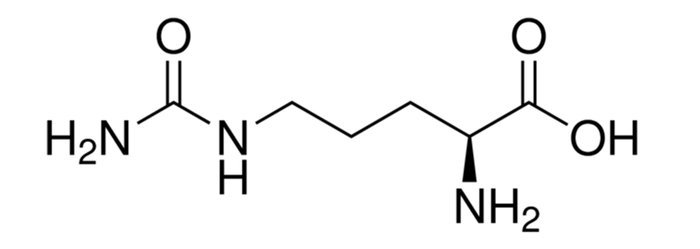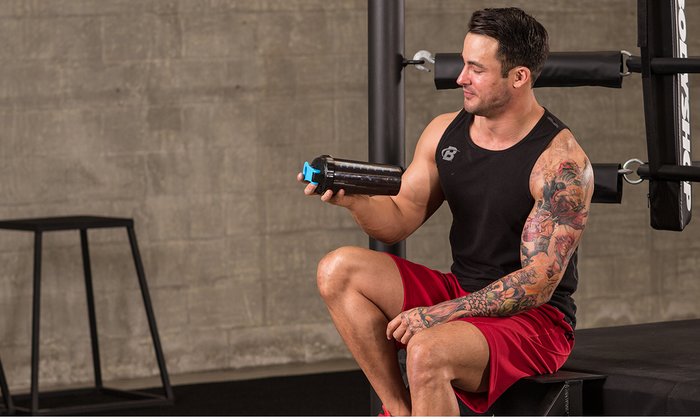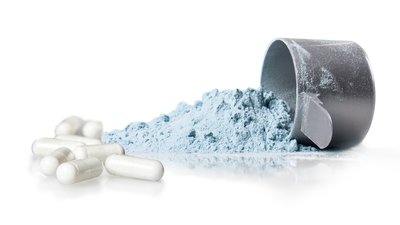Citrulline used to go right alongside arginine in many pre-workout formulas, but arginine is increasingly left out entirely these days, and citrulline gets main billing. So what's so great about citrulline? Plenty, it turns out.
In the body, citrulline acts as an arginine precursor, meaning it's used in the production of arginine. Arginine helps stimulate nitric-oxide (NO) production, which acts as a vasodilator to open up blood vessels and increase blood flow to muscle.
So why not just take arginine instead? Simply put, arginine is subject to a more rigorous path of digestion, going through absorption in the small intestine and liver before being released into general circulation. Citrulline, on the other hand, can bypass all of this and go directly into the bloodstream, where it can boost nitric-oxide production.
The ironic upshot to all of this is that citrulline ends up being a better booster of blood arginine levels than arginine—and without arginine's side effects, which can include fairly intense digestive distress for some people.
But not all citrulline is created equal. When checking ingredient labels, you may have noticed two types of citrulline: L-citrulline and citrulline malate. Let's investigate the research and you may find one is better suited for your goals.
What Is L-Citrulline?
L-citrulline is the natural form of citrulline. Although your body produces its own supply, consuming extra citrulline can have significant performance benefits. Found naturally in fruits such as watermelon as well as on its own in certain supplements, citrulline plays a major part in two important processes. One, it helps boosts nitric-oxide levels, which can help dilate your blood vessels, allowing more oxygen and nutrients to be delivered to your muscles. It also has a role in the removal of ammonia, a compound known to cause exercise-related fatigue, from your blood.

Studies have reported improved power output, oxygen consumption, and exercise performance with as little as 2.4 grams per day over an eight-day period.[1,2] Additionally, supplementing with L-citrulline plus the antioxidant glutathione over seven days has been shown to result in increased markers of nitric oxide following repeated bouts of exhaustive resistance exercise.[3]
But before you go out and load up on watermelon, it's important to note that supplementation with L-citrulline has been shown to negatively impact running times during certain maximal-effort tests.[4] This isn't likely to affect your performance in the weight room, but competitive endurance athletes may not want to take this version before important training.
Does Malate Give Citrulline an Edge?
The only difference between L-citrulline and citrulline malate (CM) is the addition of malic acid. That may seem like a minor detail, but it can have a significant impact on your performance.
Malate serves as an important component in the tricarboxylic (or TCA) cycle, which is one way your body produces energy. When you increase malate levels, you increase energy production. Therefore, citrulline malate provides the one-two punch of bringing additional blood—and subsequently, oxygen and nutrients—to exercising muscles, as well as providing increased energy to boost performance levels.

Research on citrulline malate is relatively new but promising. A recent study published in the European Journal of Sport Science reported that consuming 8 grams of citrulline malate before exercise resulted in increased maximal grip strength and improved lower-body explosive power.[5] Another study conducted in advanced weightlifters found that 8 grams of CM increased the number of reps performed to failure across several sets of lower-body exercises.[6]
Besides its effects on performance, CM can also reduce post-exercise muscle soreness. Research published in the Journal of Strength and Conditioning Research found that taking 8 grams of citrulline malate one hour before completing multiple sets to failure on the bench press led to a significant decrease in muscle soreness.[7]
And the Winner Is...
Both have their strengths, but the win goes to citrulline malate. The key difference is its ability to increase both muscle pumps and performance, meaning more reps, more effective time in the gym, and better results. Another advantage to using citrulline malate is that you don't have to load with it, whereas L-citrulline is most effective after a week of steady usage. That means you can take it right before your workout and experience immediate performance benefits.

Whether you decide on L-citrulline or citrulline malate, make sure to take the correct dosage. If you opt for L-citrulline, take 2.4-6.0 grams per day for a minimum of seven days. With citrulline malate, 6-8 grams has been shown to yield benefits about an hour before exercise without using a loading phase.
Top Selling Products
References
- Suzuki, T., Morita, M., Kobayashi, Y., & Kamimura, A. (2016). Oral L-citrulline supplementation enhances cycling time trial performance in healthy trained men: Double-blind randomized placebo-controlled 2-way crossover study. Journal of the International Society of Sports Nutrition, 13(1), 1.
- Bailey, S. J., Blackwell, J. R., Lord, T., Vanhatalo, A., Winyard, P. G., & Jones, A. M. (2015). L-citrulline supplementation improves O2 uptake kinetics and high-intensity exercise performance in humans. Journal of Applied Physiology, 119(4), 385-395.
- McKinley-Barnard, S., Andre, T., Morita, M., & Willoughby, D. S. (2015). Combined L-citrulline and glutathione supplementation increases the concentration of markers indicative of nitric oxide synthesis. Journal of the International Society of Sports Nutrition, 12(1), 1-8.
- Hickner, R. C., Tanner, C. J., Evans, C. A., Clark, P. D., Haddock, A., Fortune, C., ... & Mccammon, M. (2006). L-citrulline reduces time to exhaustion and insulin response to a graded exercise test. Medicine and Science in Sports and Exercise, 38(4), 660-666.
- Glenn, J. M., Gray, M., Jensen, A., Stone, M. S., & Vincenzo, J. L. (2016). Acute citrulline-malate supplementation improves maximal strength and anaerobic power in female, masters athletes tennis players. European Journal of Sport Science, 1-9.
- Wax, B., Kavazis, A. N., Weldon, K., & Sperlak, J. (2015). Effects of supplemental citrulline malate ingestion during repeated bouts of lower-body exercise in advanced weightlifters. The Journal of Strength & Conditioning Research, 29(3), 786-792.
- Pérez-Guisado, J., & Jakeman, P. M. (2010). Citrulline malate enhances athletic anaerobic performance and relieves muscle soreness. The Journal of Strength & Conditioning Research, 24(5), 1215-1222.

